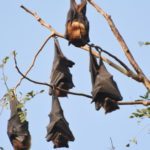Lien vers Pubmed [PMID] – 29351657
Lien DOI – 10.1093/infdis/jiy015
J Infect Dis 2018 04; 217(9): 1390-1394
Nipah virus is a zoonotic virus harbored by bats and lethal to humans. Bat-to-human spillovers occur every winter in Bangladesh. However, there is significant heterogeneity in the number of spillovers detected by district and year that remains unexplained. We analyzed data from all 57 spillovers during 2007-2013 and found that temperature differences explained 36% of the year-to-year variation in the total number of spillovers each winter and that distance to surveillance hospitals explained 45% of spatial heterogeneity. Interventions to prevent human infections may be most important during colder winters. Further work is needed to understand how dynamics of bat infections explains spillover risk.



